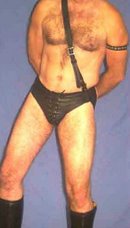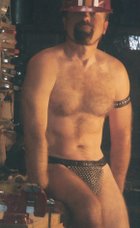
 If you haven't watched it, Mad Men on AMCTV is an awesome look at the golden age of advertising in the early 1960's and explores, among many topics, the input of gay men in the industry, especially the art work.
If you haven't watched it, Mad Men on AMCTV is an awesome look at the golden age of advertising in the early 1960's and explores, among many topics, the input of gay men in the industry, especially the art work.The article below has a link: http://www.washblade.com/2007/9-21/arts/books/11284.cfm
Taking the ‘Hint’ Gay Former George Mason professor chronicles gay-friendly marketing in new book on advertising
ZACK ROSEN Friday, September 21, 2007
ZACK ROSEN Friday, September 21, 2007
Before there was a widespread gay media, before publications like The Advocate could show car ads with two men holding hands, advertising executives had to find more subtle ways to court the gay and lesbian consumer.
Bruce H. Joffe’s new book, “A Hint of Homosexuality: ‘Gay’ and Homoerotic Imagery in American Print Advertising” documents ads, starting in 1905, that would raise eyebrows even among gay people living in 2007.
“Hints of Homosexuality” grew from an article Joffe wrote on homoerotic imagery in Ivory Soap ads from the early part of the century. Entitled “.056/100% ... Homosexual,” the piece explores imagery that is undeniably gay friendly. “[Those ads] are amazing,” Joffe says, describing in particular one that is set in a locker room. “You can see pubic hair! The other guys are looking at it.”
Joffe’s interest in early gay advertising began as a hobby. He had a number of early ads framed on the walls of his house and friends frequently suggested that they should be compiled and published. EBay searches raised his collection to over 300 pieces. Though the visual nature of the ads would lend itself best to a coffee table book or full color volume, practical concerns made an academic work the more viable option.
“You are talking about a niche within a niche,” Joffe says. “There’s no money [for the publisher] in making this a coffee table book. Being a professor, you have to publish or perish. I tried to write the book with a popular voice so that anyone could pick it up, could look at the words and say ‘He’s right, I never noticed this before.”LEAFING THROUGH “HINT” forces the reader to look at old marketing in a new light.
The book gives many examples of coding, the subtle images inserted in print advertising that would go unnoticed by a straight reader but perk the attention of an informed gay man or lesbian. “If an advertising illustrator dressed someone in red, had someone lighting someone else’s cigarette [it meant something gay,]”
Joffe says. “Sex sells, it has always sold. People in marketing always knew that there is more than one market. There was no LOGO, no Blade. How do you reach these people? You reach them by encoding.” Joffe sites many examples of “gay vague” advertising in the book.
A 1948 ad for Schlitz beer used the tagline “I was curious…I tasted it” and a three panel set up. In the first frame, two men and two women are being served the beer. In the second frame, the men stand next to each other while trying the beer, and in the third frame the women are gone completely, implying that the rewards of their curiosity include more than just “the beer that made Milwaukee famous.”
Joffe’s interest in gay advertising goes beyond the casual or the educational. He is donating all profits from “Hint” to the Commercial Closet Association, a non-profit that seeks to influence advertisers to include gay populations in their marketing. The association also maintains an archive of gay-inclusive television advertising from around the world, a collection that Joffe is adding to by lending all of his hard copies of the ads documented in the book. “This organization is trying to reach a point where it doesn’t matter who is pictured in the ad, but that we’re all respecting each other while advertisers are making money,”
Joffe says. “I am loaning them my collection of print ads so there can be a museum that documents and chronicles the history of gays in advertising.”
So, those male underwear ads in the old Sears, Montgomery Wards and JC Penny catalogs weren't the only ones out there in the 1960's and early 1970's to draw the curiosity of an young adolescent gay male. Oh, the power of advertising!!!!
So, those male underwear ads in the old Sears, Montgomery Wards and JC Penny catalogs weren't the only ones out there in the 1960's and early 1970's to draw the curiosity of an young adolescent gay male. Oh, the power of advertising!!!!











4 comments:
I remember those catalogs when I first visited America some 15 years ago. I was quite surprised at how much male hotness was all over the media.
Yes it has always been out there and I hope it continues :P
Maybe it is that we all have GSP - Gay Sensory Perception. Kind of like Gaydar only a more advanced version! OK I am walking off the grid here, but don't you think as gay men we are more prone to notice the hidden messages. More so than a straight man who isn't all that interested in the sexual message these advertisments send?
Just a thought!
hugs friend
xoxo
I can recall in the late eighties, the first time I ever received an International Male catalogue in the mail, (sent by some mysterious gay prescient merchandising entity, perhaps, as I certainly didn't ask for it!). What an unusual, eroticized booklet of guys in speedos and skimpy underwear, I thought at the time... not even realizing the overtly gay overtones, (hey, it was the 80s... even straight guys wore speedos, tight jeans, and short-shorts back then). I know it's become somewhat of a punchline now, but those IM catalogues probably were a lot of gay guys' first exposure to homoerotic imagery.
Post a Comment